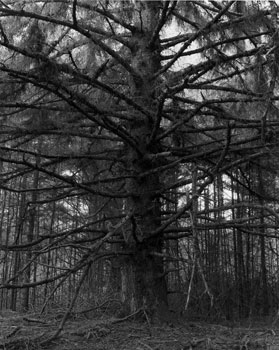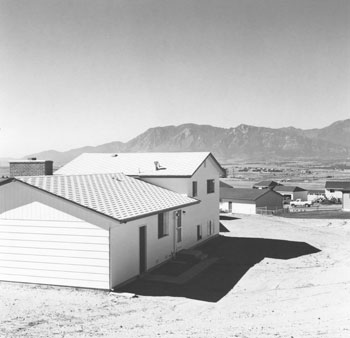
Robert Adams was born in Orange, New Jersey in 1937. His refined black-and-white photographs document scenes of the American West of the past four decades, revealing the impact of human activity on the last vestiges of wilderness and open space. Although often devoid of human subjects, or sparsely populated, Adams’ photographs capture the physical traces of human life: a garbage-strewn roadside, a clear-cut forest, a half-built house. An underlying tension in Adams’ body of work is the contradiction between landscapes visibly transformed or scarred by human presence and the inherent beauty of light and land rendered by the camera. Adams’ complex photographs expose the hollowness of the 19th Century American doctrine of Manifest Destiny, expressing somber indignation at the idea (still alive in the 21st Century) that the West represents an unlimited natural resource for human consumption. But his work also conveys hope that change can be effected, and it speaks with joy of what remains glorious in the West. Adams received a BA from the University of Redlands in California and a PhD in English from the University of Southern California. He has received numerous awards, including a John D. and Catherine T. MacArthur Foundation Award (1994); the Spectrum International Prize for Photography (1995); and the Deutsche B√∂rse Photography Prize (2006). Major exhibitions include the San Francisco Museum of Modern Art (2005); Yale University Art Gallery, New Haven (2002); Denver Art Museum (1993); Philadelphia Museum of Art (1989); and the Museum of Modern Art, New York (1979). Adams lives and works in northwestern Oregon.

Watch a clip from Adams’ Art:21 segment.
About his work, Adams says, “I’d like to document what’s glorious in the West and remains glorious, despite what we’ve done to it. I’d like to be very truthful about that. But I also want to show what is disturbing and what needs correction…You’re always in quest for the picture which will catch both, and occasionally that happens.”(excerpted from the companion book Art in the Twenty-First Century 4, p. 66).

Read more about his work and watch additional clips on his Art:21 webpage here.
Have you experienced Adams’ work in person, or did you have an opportunity to view his segment in one of the hundreds of Art21 Access ’07 events that have been taking place all month? Share your thoughts on Robert Adams by leaving a comment below.



